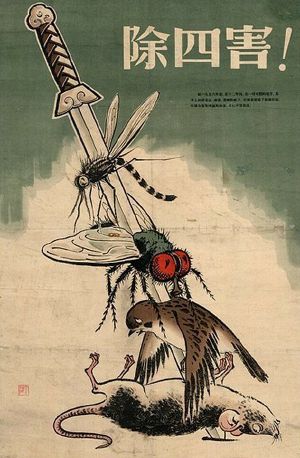Four Pest campaign
Mosquitoes, flies, rats and sparrows - these four so-called plagues were to be destroyed at the end of the 1950s under Mao Zedong's rule. Mao was certain that this was "the great leap forward" to combat economic and social social inequalities in the country. The calculation seemed logical. One sparrow eats about 2 to 4 kilos of grain a year and, on this assumption, by killing one million sparrows, 60,000 people could already gain food. One killing method was distrubing birds with incredible noise until they would fell to earth. The extermination was successful, but the death of the birds was followed by a raising population of insects and thus a plague of grasshopper. The result: the great famine between 1959 and 1961. In 1960 sparrows were placed in the agenda by bed bugs. It is said that a quarter of a million sparrows were later imported from the USSR to China. Today, sparrows are allowed to live in peace again nevertheless they become a rare species in China.
Stories like that are trageic but no individual case. Human beings always find a way of disturbing nature and its balance.
At the beginning of the 20th century, the North America was brought to Europe - for the fur industry. At some point, the animals were able to escape from their cages. Today they are considered a plague, as they have hardly any natural enemies in Central Europe. The situation is similar with raccoon dogs from Japan. Lynx, wolves, brown bears or, in the case of offspring eagle owls can also become enemies. The most common cause of death for raccoons is traffic.

